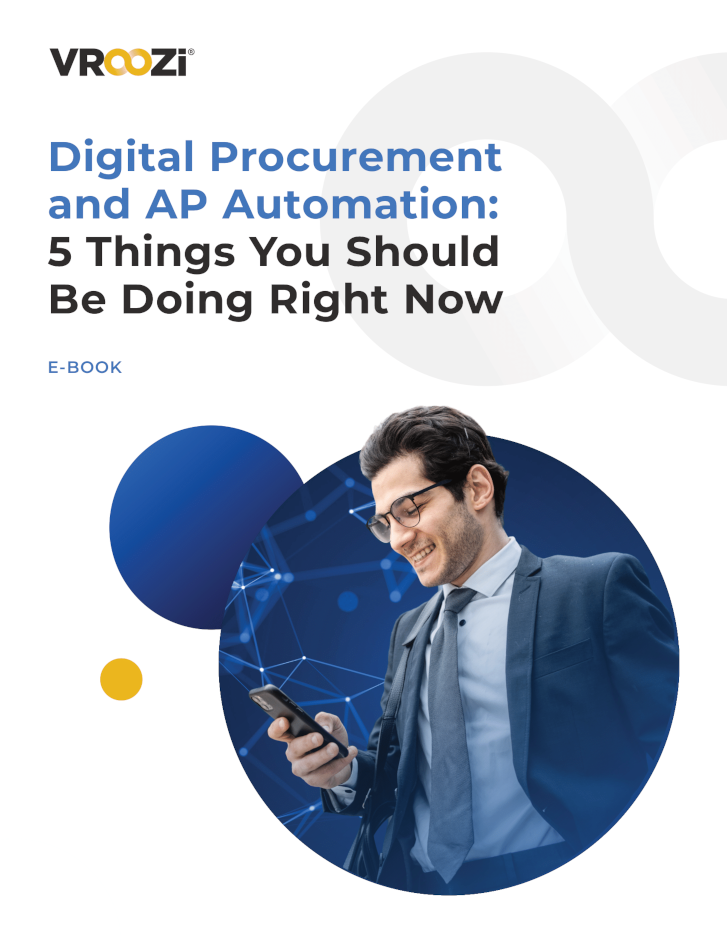Chapter 3
5 Ways to Use Digital Procurement and Automation to Surpass Goals
As advanced technology reshapes what P2P operations can accomplish, most leaders recognize the opportunity to fast-track their goals. However, it can be tough to know how to get started. Here are the five things organizations need to do right away to upgrade their P2P operations:
1. Digitize suppliers.
Suppliers are often not digitally enabled, meaning extra work for your teams. For instance, if you have a supplier that submits handwritten or PDF invoices, someone on your team will need to stop their current work, manually type the paper invoice information into your digital payment or ERP system, and ensure the invoice matches a PO. Any typing error or other mistake means more delays as that employee wanders the halls to track down more information.
Now imagine the damage these process inefficiencies cause when multiplied across hundreds of suppliers. In addition to wasting time and money, these process interruptions feed inaccurate data into your digital systems and throw off sourcing decisions, budgets, forecasting, and more. That’s why digitizing suppliers is so important.
Are you wondering how to get started? P2P solutions are designed to encourage more digitally enabled suppliers and keep data flowing through your digital system at every point of your P2P pipeline. Advanced P2P solutions use cognitive optical character recognition (OCR) to scan handwritten or PDF invoices and automatically transfer data into your digital system—saving time, reducing errors, and keeping accurate spend data flowing. Ultimately, this platform’s centralized digital marketplace and automation functions help connect purchasing, suppliers, AP, procurement, and all of the moving pieces of your P2P ecosystem into one place.
2. Adopt straight-through processing.
Straight-through processing can speed up the P2P process, accelerate payments, and increase opportunities to cash in on early-payment discounts. Unfortunately, purchase order and invoicing problems hold up most organizations’ P2P operations.
Most companies use two-way or three-way matching to reduce errors, cut down on fraud, and ensure accurate spend data. For three-way matching, that includes lining up POs, goods receipts or service confirmations, and supplier invoices. Two-way matching requires matching POs and invoices. If POs are missing or any documents include mistakes, it can disrupt an employee’s day.
“According to Ardent Partners, straight-through processing rates for invoices have remained flat at 30.2% of the total invoice count.”
This is another area in which automated P2P solutions dramatically speed up your processes. Advanced solutions automate two- and three-way matching, even when your team receives handwritten invoices or has to process a non-PO transaction. That can eliminate errors, speed up payments, and carve out swaths of free time for employees. Combining eProcurement and eInvoicing processes in an integrated P2P process maximizes straight-through processing (STP), where the system approves invoices for payment without any human intervention.
3. Improve your data.
Most organizations have limited spend visibility or inaccurate data to work with. That’s because manual P2P processes are vulnerable to errors. At the same time, when rogue spending is high, procurement won’t be able to see where employees are spending or who the organization is working with.
The result? When financial leaders have limited spend visibility, it’s difficult to make wise strategic sourcing decisions, build supply chain resilience, lower costs, and identify ways to improve the organization’s financial picture.
Digital procurement solutions can improve data in multiple ways. First, they automate the P2P process, reduce errors, and ensure more accurate data flows through to reports. Second, they increase spend under management and boost spend visibility, allowing procurement to see everything they need to build an effective procurement strategy.
4. Embrace automation.
Despite rapid technological advancements, most P2P processes are long overdue for a refresh. Many P2P operations rely on hand-typed information, spreadsheets, and manual inputs, leading to mistakes and wasted time. This is why embracing AP automation is essential to achieve more P2P efficiency.
Automated P2P solutions empower employees to make purchases, automate PO creation, and approve POs in a matter of clicks. These solutions also identify overpayments, mismatches, and flag duplicates. This leads to lower costs per invoice or PO, shorter cycle times, and a more profitable P2P process.
5. Educate stakeholders.
The final thing financial leaders can do to push P2P improvements into motion is educate stakeholders. It’s not always obvious, but adopting digital procurement and P2P solutions can benefit a wide range of stakeholders. Here are a few ways these solutions can benefit different groups:
- Suppliers: Suppliers may think digitizing processes means more work for them. However, P2P solutions connect them directly to your employees and make it easy for your team to purchase and collaborate with suppliers through a centralized digital marketplace. Ultimately, these solutions speed up payments and free up your leaders to give suppliers more attention.
- Procurement: Digital procurement and P2P solutions widen your procurement team’s spend visibility, free them up for more strategic work, and lay out accurate, thorough data. That all enables procurement to make smarter spend management decisions.
- Accounts Payable (AP): An AP automation solution can help your AP team reduce fraud, remove errors, and process invoices faster with less touches. These platforms increase straight-through invoice processing, automatically complete three-way matching, and improve the entire AP process—eliminating tasks that often spark frustrations.
"According to Bain Consulting, 80% of procurement professionals believe they need to do more to take advantage of the latest digital tools."
When all these stakeholders are connected and working together, it improves the entire P2P operation. Educating stakeholders about these digital procurement and automated P2P solutions can help turn them into supporters.



